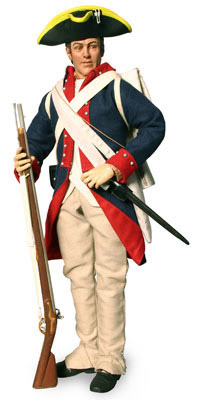United States
|
Great Britain
|
|
Strengths : *strong welll trained army and navy *strong central goverment with available funds *support of colonial loyalist and native americans Weaknesses:*large distance separating britain from battlefields *troops unfamiliar with terrain *weak milatary leaders *sympathy of certain british politicians for the american cause |

|
|
Battles: |
Details: |
|
|
Battle of Bunker Hill : |
The Battle of Bunkerhill was fought on June 17, 1775. The Americans wanted to keep the British from leaving the city. They received a message that the British were going to secure the hills, so the Americans invaded the area. The Americans wanted to take over Boston, and they wanted to get revenge on the British forces for shooting them in their backs when they were retreating at Lexington. |
|
On May 10, 1775, Ethan Allen and Benedict Arnold led 83 Americans called the Green Mountain Boys through the morning fog. They easily took over the 45 man British garrison at Fort Ticonderoga, New York without a shot being fired. It was located at the southern tip of Lake Champlain. The capture of Crown Point, New York on May 11th gave the patriots control of Lake Champlaign and opened up Canada to invasion from the south. |
Saratoga: |
The Battle of Long Island was an engagement of the American Revolution. The battle was waged on August 27, 1776 and ended on August 30, 1776. This was the first large-scaled battle of the war and had two commanding officers, George Washington and William Howe. The whole ideal of the war was a British campaign to seize New York City during the American Revolution. General George Washington had sent out one-third of his troops across the East River to Brooklyn Heights from the American headquarters on Manhattan Island, where they constructed strong enough entrenchments. There was a defect in their plan. You see, by George Washington sending out 4,000 men to guard the Heights of Guana, he left the left flank un-defendable and vulnerable. They failed to protect it, which caused the Americans to lose more than a thousand men. Howe only lost 400 men. The Americans retreated to their Brooklyn Entrenchments, and during the night of August 29-30th, Washington took his demoralized army back to their headquarters on Manhattan Island. |
Battle of Long Island: |
The Battle of Long Island was an engagement of the American Revolution. The battle was waged on August 27, 1776 and ended on August 30, 1776. This was the first large-scaled battle of the war and had two commanding officers, George Washington and William Howe. The whole ideal of the war was a British campaign to seize New York City during the American Revolution. General George Washington had sent out one-third of his troops across the East River to Brooklyn Heights from the American headquarters on Manhattan Island, where they constructed strong enough entrenchments. There was a defect in their plan. You see, by George Washington sending out 4,000 men to guard the Heights of Guana, he left the left flank un-defendable and vulnerable. They failed to protect it, which caused the Americans to lose more than a thousand men. Howe only lost 400 men. The Americans retreated to their Brooklyn Entrenchments, and during the night of August 29-30th, Washington took his demoralized army back to their headquarters on Manhattan Island. |
Yorktown: |
Yorktown was the area where the last major battle of the American Revolution War took place. The U.S. forces and the forces from France worked together to give the British froces under Cornwallis a massive defeat. In July 1780, about 5,500 French soldiers led by Lieutenant General Jean Rochambaeu, arrived in America. George Washington still hoped to force the troops from Britain out of New York City in an operation combined with France. Washington learned that an enormous fleet from France headed toward Virginia in August 1781. The fleet was under Admiral Francois Grasse. He planned to prevent Cornwallis from escaping by ocean, by obstructing Chesapeake Bayy. The French forces, led by Rochambeau, and the American forces under Washington hurried southward to capture Cornwallis on land. Admiral Grasse battled a naval force from Britain that sailed from New York to Chesapeake Bay's mouth in the beginning of September. The British then returned to New York to repair after several days of battle. An allied French and American force of approximately 18,000 sailors and soldiers encircled Cornwallis at Yorktown by the end of September 1781. On the night of October 16th, Cornwallis tried to bring his forces over the York River to safety. A storm had driven them back which caused Cornwallis to capitulate the next day. On October 19, 1781, Cornwallis surrendered. |
Home | Acts | Declaration Of Indapendence | Revolutionary War | Thomas Jefferson | George Wasgington



